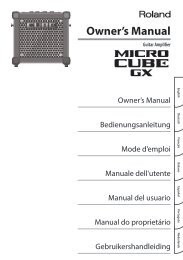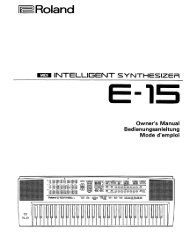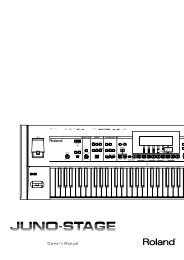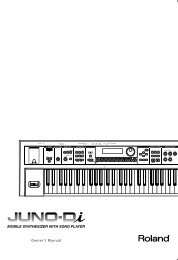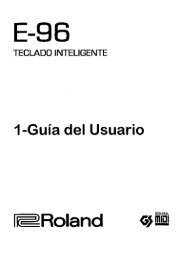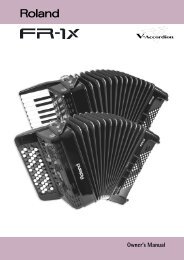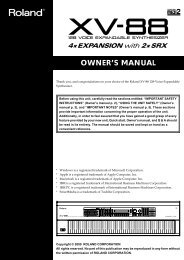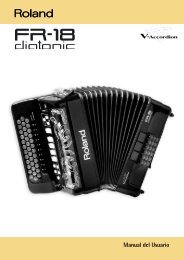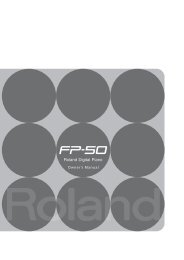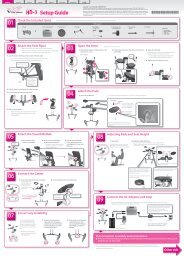Owner's Manual - Roland
Owner's Manual - Roland
Owner's Manual - Roland
You also want an ePaper? Increase the reach of your titles
YUMPU automatically turns print PDFs into web optimized ePapers that Google loves.
fig.06-031.e<br />
Value: -100, -90, -80, -70, -60, -50, -40, -30, -20, -10, 0,<br />
+10, +20, +30, +40, +50, +60, +70, +80, +90, +100<br />
P-Env Time 1–4 (Pitch Envelope Time 1–4) ★<br />
fig.06-032.e<br />
Time<br />
C1 C2 C3 C4 C5 C6 C7<br />
Specify the pitch envelope times (Time 1–Time 4). Higher<br />
settings will result in a longer time until the next pitch is<br />
reached. (For example, Time 2 is the time over which the<br />
pitch changes from Level 1 to Level 2.)<br />
Value: 0–127<br />
Pitch L0<br />
L1<br />
Note on<br />
P-Env Level 0–4 (Pitch Envelope Level 0–4)<br />
Specify the pitch envelope levels (Level 0–Level 4). It<br />
determines how much the pitch changes from the reference<br />
pitch (the value set with Coarse Tune or Fine Tune on the<br />
Pitch screen) at each point. Positive (+) settings will cause the<br />
pitch to be higher than the standard pitch, and negative (-)<br />
settings will cause it to be lower.<br />
Value: -63– +63<br />
-100<br />
0<br />
-50<br />
+50<br />
+100<br />
T1 T2 T3 T4<br />
T: Time L: Level<br />
L2<br />
L3<br />
Note off<br />
Key<br />
L4<br />
Time<br />
Patch TVF<br />
Filter Type<br />
Creating a Patch<br />
Modifying the Brightness of a Sound<br />
with a Filter (TVF/TVF Env)<br />
Selects the type of filter. A filter cuts or boosts a specific<br />
frequency region to change a sound’s brightness, thickness,<br />
or other qualities.<br />
Value<br />
OFF: No filter is used.<br />
LPF: Low Pass Filter. This reduces the volume of all<br />
frequencies above the cutoff frequency (Cutoff<br />
Freq) in order to round off, or un-brighten the<br />
sound. This is the most common filter used in<br />
synthesizers.<br />
BPF: Band Pass Filter. This leaves only the frequencies<br />
in the region of the cutoff frequency (Cutoff<br />
Freq), and cuts the rest. This can be useful when<br />
creating distinctive sounds.<br />
HPF: High Pass Filter. This cuts the frequencies in the<br />
region below the cutoff frequency (Cutoff Freq).<br />
This is suitable for creating percussive sounds<br />
emphasizing their higher tones.<br />
PKG: Peaking Filter. This emphasizes the frequencies in<br />
the region of the cutoff frequency (Cutoff Freq).<br />
You can use this to create wah-wah effects by<br />
employing an LFO to change the cutoff<br />
frequency cyclically.<br />
LPF2: Low Pass Filter 2. Although frequency<br />
components above the Cutoff frequency (Cutoff<br />
Freq) are cut, the sensitivity of this filter is half<br />
that of the LPF. This makes it a comparatively<br />
warmer low pass filter. This filter is good for use<br />
with simulated instrument sounds such as the<br />
acoustic piano.<br />
LPF3: Low Pass Filter 3. Although frequency<br />
components above the Cutoff frequency (Cutoff<br />
Freq) are cut, the sensitivity of this filter changes<br />
according to the Cutoff frequency. While this<br />
filter is also good for use with simulated acoustic<br />
instrument sounds, the nuance it exhibits differs<br />
from that of the LPF2, even with the same TVF<br />
Envelope settings.<br />
If you set “LPF2” or “LPF3,” the setting for the Resonance<br />
parameter will be ignored (p. 110).<br />
109<br />
Overview Connections VS-700C Console VS-700R I/O Fantom VS Appendix



